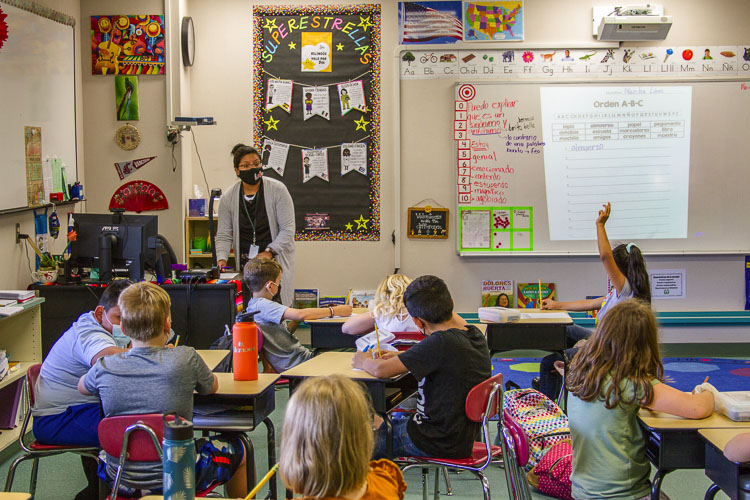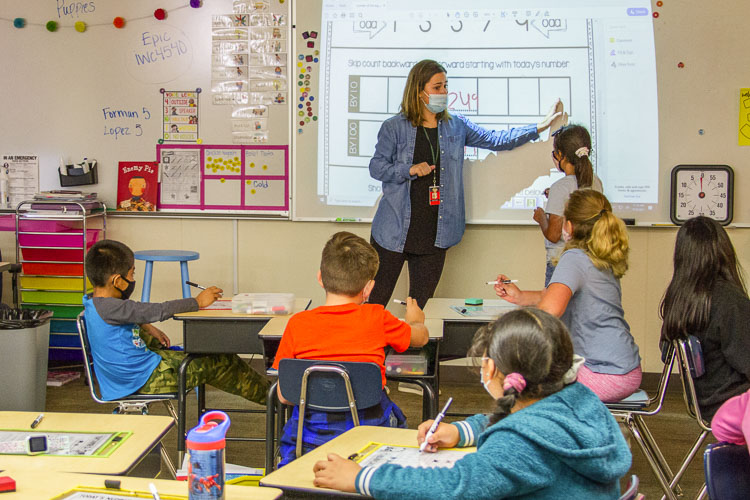The program can enroll up to 44 students at each grade level with the goal to maintain a 50/50 enrollment between native English speakers and native Spanish speakers
Woodland Public Schools’ Dual Language Program offers the opportunity for students starting in kindergarten to learn and use both English and Spanish during every school day. Now in its fourth year at Columbia Elementary School, the Dual Language Program offers bilingual learning for students from grades K-3.

The program can enroll up to 44 students at each grade level with the goal to maintain a 50/50 enrollment between native English speakers and native Spanish speakers.
“Keeping the program balanced is key as the students help teach one another their own native language,” said David Starkey, Columbia Elementary School’s principal. “By maintaining an even enrollment of native speakers, we effectively create a teaching-learning environment where students help each other and thereby internalize the lessons as studies show teaching someone else will make for more effective learning for both the student teaching and the student learning.”
Teachers watch first-hand as students teaching one another improves their own learning.
“Students own their learning because they’re part of the process of teaching it,” said Maria Rodriguez, first grade teacher in the program. “By using their knowledge to teach other students, they become more engaged and part of the learning process.”
Jill Thoeny, the program’s kindergarten teacher, agreed with Rodriguez. “Additionally, the act of teaching each other elevates the students’ grasp of their own native language, too,” she said. “The act of teaching brings agency to their learning because they’re driving their own learning.”
Scheduling and finding bilingual teachers present the biggest challenges to running a dual language program in a traditional elementary school.
“We have to create schedules for dual language in addition to our monolingual students to ensure all of our teaching staff receives as much planning time as possible,” explained Starkey. “Also, with other districts throughout the state offering dual language programs, the competition for bilingual teachers can be intense.”
The administration realized finding bilingual teachers might present a challenge when the school first launched the program which resulted in a unique solution – students spend half of each school day learning in Spanish and the other half learning in English.
“By dividing the day in half, we can have one fluent Spanish teacher work with an English-speaking teacher so both teachers can have twice as many students,” said Starkey. “Where a teacher would typically have 22 students all day long, two teachers working together can accommodate the entire 44 student grade by teaching all of them half of each day.”

To further incorporate the lessons of dual language into the school’s culture, all materials are printed in both English and Spanish schoolwide.
“We love having the program at the school and are in the process of making Spanish part of the school’s culture in a variety of ways including reciting of the Pledge of Allegiance in both English and Spanish each morning,” said Starkey. “The program brings cultural awareness to everything we do throughout the school, and we’re constantly finding new ways to add even more elements of Hispanic heritage to every student’s school day.”
Thoeny enjoys watching the entire school’s pride grow in the Dual Language Program. “I’m watching our entire school transform into a multilingual, multicultural environment,” she said. “With the students modeling the program throughout the school, our whole school is proud of having a bilingual program on campus.”
Additionally, parents and families have reported how impactful the Dual Language Program has been outside of school.
“Parents are watching their students become multicultural citizens of the world,” said Thoeny. “The idea of incorporating elements of the many different cultures we have in the United States to become a multicultural citizen is a key part of our program’s mission.”
Both native-speaking English and Spanish families report the benefits of the program. For native Spanish-speakers, having their students formally learn the language and culture has been a huge boon.
“In traditional monolingual school, students who grow up in a Spanish-speaking culture lose some of their heritage since they don’t have to learn and use Spanish in school,” explained Rodriguez. “Our native Spanish-speaking families are excited their students are reading, writing, and using Spanish each and every day.”
Even though the program is already in its fourth year, teachers, staff, and students recognize the unique opportunity dual language learning presents. “I feel honored and privileged to be able to be a part of this program since the beginning,” said Rodriguez. “As a native Spanish-speaker myself, having the opportunity to use the language with almost everyone has been truly special.”
The program’s popularity continues to increase each year and the district plans to continue the program into the middle school in the coming years. In fact, Woodland Public Schools recently received a $100,000 two-year grant to enhance the Dual Language Program at Columbia Elementary permitting the staff to buy additional classroom materials and curriculum; provide additional training and professional development; and to broaden the program into Woodland Middle School when the time comes.
“The biggest question we get is from families who are curious what the program’s going to look like at the middle school,” said Starkey. “ We’re excited to receive this grant because it helps us do just that – plan for the program’s expansion when our elementary DLP students move on in their academic careers.”
For more information
Families interested in enrolling their students in the program don’t need to be bilingual themselves and students do not need to have any prior knowledge of their non-native language. Additionally, there are no screening criteria for students to enroll – all students are eligible. Applicants are accepted in the order of their application date and the district has a designated lottery-system should the number of applicants exceed the number of available classroom spots.
Although there is no additional cost to enroll, parents and guardians must remember that the true benefits from a dual language program involve a long-term commitment and should plan for their student to continue enrollment in the program for the grades following kindergarten, too.
To learn more, visit the Dual Language Program website at www.woodlandschools.org/DLP
Information provided by Woodland School District.




